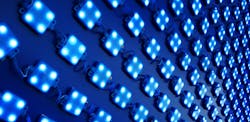High-speed solar-blind Li-Fi is possible with deep-ultraviolet LEDs
Optical wireless communications, sometimes called "Li-Fi," are one approach to increasing short-distance data-transmission rates between devices; however, the sun and other light sources can interfere with this transmission. One possible way to prevent this would be to use deep-ultraviolet (DUV) LEDs for transmission, as the operation wavelength is "solar-blind," meaning the sun (and many other light sources) produce virtually no radiation at DUV wavelengths.
But larger DUV LEDs, which produce more output power, have slower modulation rates, so how to have both high power and high data-transmission rates has been a problem. Now, Researchers at Tohoku University (Sendai, Japan) have solved the problem by creating DUV LED light sources that consist of numerous microLEDs, thus keeping both optical output and data rate high.1
"Deep ultraviolet LEDs are currently mass produced in factories for applications related to COVID-19," says Kazunobu Kojima, a scientist at the Multidisciplinary Research for Advanced Materials at Tohoku University, noting that DUV light is used for sterilization processes as well as in solar-blind optical wireless communications. "So, they're cheap and practical to use."
The researchers fabricated the DUV LEDs on sapphire templates, which are considered an inexpensive substrate, and measured their transmission speed. They found that the DUV LEDs were smaller and much quicker in their communications than traditional LEDs at that speed. "The mechanism underlying this speed is in how a lot of tiny LEDs self-organize in a single deep ultraviolet LED," Kojima says. "The tiny LED ensemble helps with both power and speed."
The researchers want to use the DUV LEDs in 5G wireless networks. "Li-Fi's critical weakness is its solar dependency," Kojima says. "Our DUV LED-based optical wireless technology can compensate for this problem and contribute to society, I hope."
Source: http://www.tohoku.ac.jp/en/press/faster_leds_for_wireless_communications.html
REFERENCE:
1. K. Kojima et al., Applied Physics Latters (2020); https://doi.org/10.1063/5.0013112.

John Wallace | Senior Technical Editor (1998-2022)
John Wallace was with Laser Focus World for nearly 25 years, retiring in late June 2022. He obtained a bachelor's degree in mechanical engineering and physics at Rutgers University and a master's in optical engineering at the University of Rochester. Before becoming an editor, John worked as an engineer at RCA, Exxon, Eastman Kodak, and GCA Corporation.
